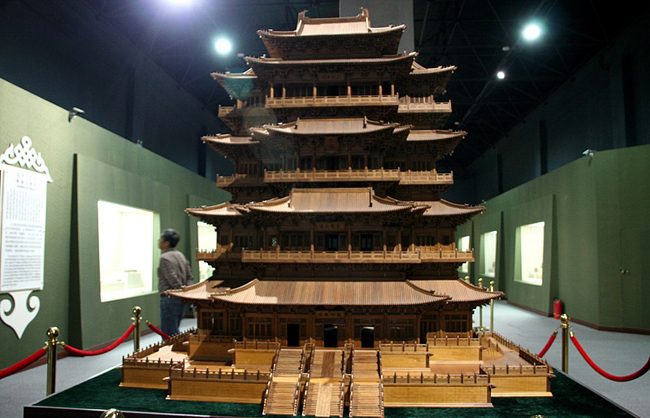Distribution and characteristics of grassland heritage in Inner Mongolia

A model of the Tai’an Mansion, the most splendid structure in Xanadu, is displayed in the Xanadu Site Museum.
The Inner Mongolia Autonomous Region is vast. During its long-term geological evolution, high mountains, grasslands, plains, basins, deserts and other complicated natural landscapes took shape in this land. The complex natural environment also led to a diverse cultural environment in Inner Mongolia. Various ethnic minorities such as the Beidi, Xianbei, Tujue, Uygur, Khitan, Jurchen and Mongolian peoples have been living and working there for generations. The integration of various ethnic groups led to enormously rich historical and cultural roots in Inner Mongolia and helped establish the profound cultural legacy that exists there today.
General situation
An initial examination of Inner Mongolia reveals that there are more than 21,000 cultural relic sites and 141 key cultural relic sites under state protection as well as 319 key cultural relic sites under the protection of the autonomous region. These precious cultural relics, often in the form of ruins, represent a key aspect of the prairie civilization and reveal the key frameworks of Inner Mongolia’s grassland culture.
Most of the 11,0000 or so cultural relic ruins come from the Liao, Jin and Yuan dynasties. They come in many different scales and styles, representing an important facet of global history. The region of Chifeng City in eastern Inner Mongolia used to be the capital city of the Liao Dynasty and the political center of the Khitan people. This region has the remains of two capital cities—the upper capital and the middle capital of the Liao Dynasty, and three imperial mausoleums of Liao emperors. Historical materials indicate that in the Liao Dynasty, large-scale urban construction emerged in China’s northern grasslands.
Ancient Inner Mongolia was the origin of the Yuan Dynasty, and its founding capital city—the upper capital of the Yuan Dynasty—was established there. The city site of the world-renowned Yuan upper capital, known as the Site of Xanadu, is today located at the Zhenglan Banner range in Xilingol League, which was once an international metropolis. In 2012, the 36th Session of the World Heritage Convention recognized the Site of Xanadu as a world cultural heritage item.
Surrounding the Site of Xanadu, various Yuan city ruins are scattered all over the grasslands, indicating their important role in the Silk Road. These ruins also represent the kernel of Inner Mongolia’s cultural heritage.
Characteristics
The unique natural environment and lack of human interference mean that most of the cultural heritage of Inner Mongolia is well preserved. The most notable aspect of cultural heritage in Inner Mongolia is the fact it has been well preserved. In recent years, there has been a series of archaeological discoveries and the preservation of this area’s cultural heritage has made great strides. The cultural heritage system of Inner Mongolia has distinct ethnic and regional characteristics and reflects the strong potential for cultural development in Inner Mongolia.
For instance, Inner Mongolia is rich in ancient rock paintings. More than 30,000 ancient rock paintings are well preserved and distributed in Xilingol League, Ulanqab, Bayannur and Alxa along the Yinshan Mountain range. The rock art stretches for thousands of kilometers from east to west in Inner Mongolia and is known as the longest ancient art gallery.
Important archeological discoveries in Inner Mongolia have enormously enriched the cultural and research significance of grassland archaeology and filled gaps in Chinese archaeology.
Chen Yongzhi is the director of the Institute of Cultural Relics and Archaeology of Inner Mongolia.
